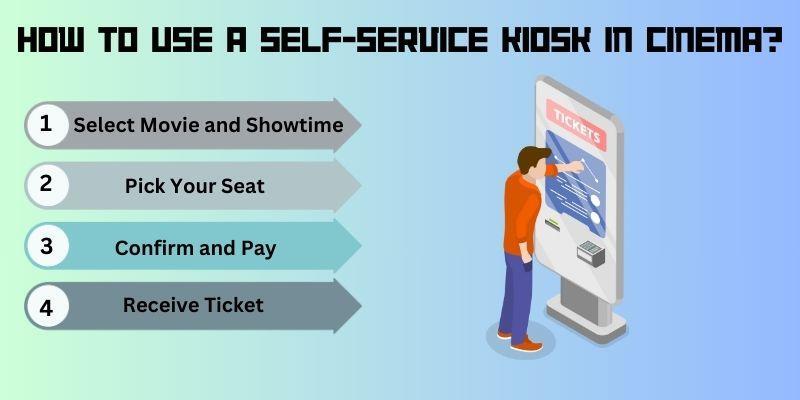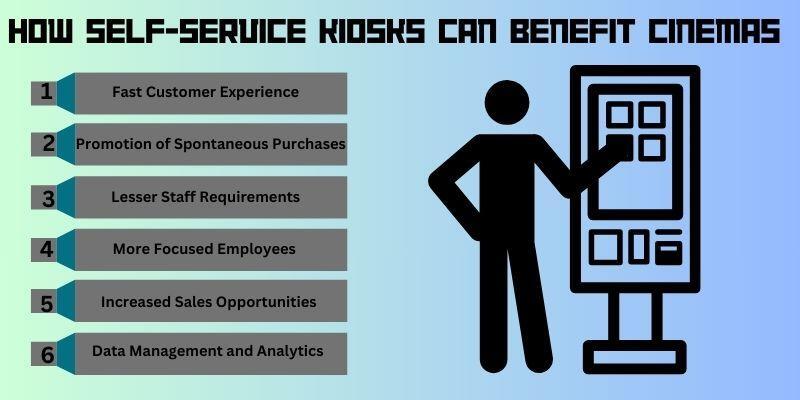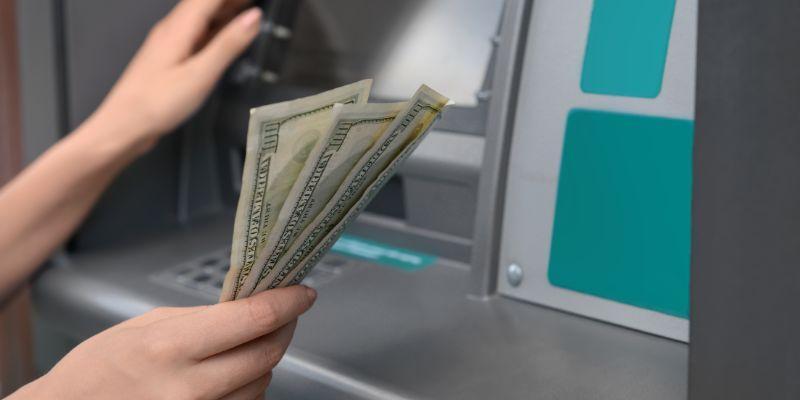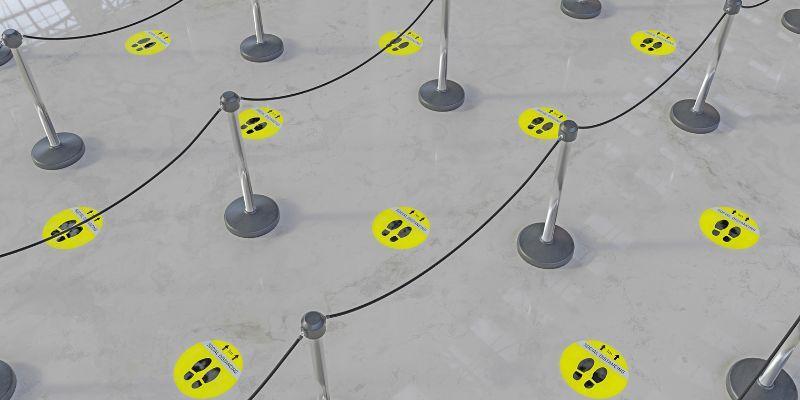The cinema industry is facing significant shifts, from the rise of streaming platforms to evolving consumer preferences.
With fewer people attending theaters, cinemas need innovative ways to attract and retain audiences. Staying relevant means adapting to these changes; one effective solution is automation.
When incorporating cinema self-service kiosks, cinemas are adopting the trend of modernization. This move mirrors advancements across various industries, where automated solutions improve customer experiences and create efficiency.
Self-service kiosks are more than a passing trend; they represent a strategic shift toward modern, uniform interactions that meet today’s consumer expectations, and this is precisely what we will explore today in this article.
How to Use a Self-Service Kiosk in Cinema?

A self-service ticketing kiosk for cinemas is a modern, user-friendly solution that allows moviegoers to purchase tickets independently, bypassing the traditional box office line.
Equipped with a touchscreen interface, these self-service kiosks offer an intuitive step-by-step guide, enabling customers to select their movie, showtime, and preferred seats before quickly finalizing their purchase.
This automated approach saves time and provides a smooth, self-directed experience, making it ideal for those who prefer a faster, more efficient ticketing process.
Here’s a closer look at how to use a movie theater kiosk effectively, with each step designed to provide an effortless cinema-going experience:
Step-by-Step Process of Using a Cinema Self-Service Kiosk
1. Select Movie and Showtime
- The first interaction with a self-service kiosk involves choosing a movie. Customers are usually greeted with a user-friendly display featuring all the available films at the cinema. Each movie option includes showtimes, dates, movie ratings, and occasionally short descriptions or trailers.
- Browsing Options: Customers can scroll through the list of films, filter by genre, or choose based on showtimes that best fit their schedule. Some kiosks even allow users to sort movies based on popularity, making it easier to pick a film if they need clarification on what they want to see.
2. Pick Your Seat
- After choosing the movie and showtime, users are directed to an interactive seating chart. This feature allows customers to view the theater’s layout, including available and occupied seats marked in different colors for easy identification.
- Seat Selection: Customers can select their preferred seats based on their comfort and preference. For example, many people choose seats in the middle of the theater for optimal viewing, while others might prefer aisle seats for easier access. This level of personalization improves customer satisfaction, as users feel more in control of their experience.
- Unique Options: In some theaters, premium or VIP seating areas may also be available through the movie theater ticket kiosk. These areas offer perks like reclining seats or better views, and the kiosk interface usually highlights these options for easy access.
3. Confirm and Pay
- Once users have selected their movie and seats, they must confirm their choice and proceed to payment. Self-service ticketing kiosks generally support various payment methods, including credit/debit cards, mobile wallets like Apple Pay or Google Pay, and sometimes cash.
- Payment Options and Security: When providing multiple payment options, kiosks make it easier for customers to complete their transactions in a way that suits them best. Kiosks are typically equipped with secure payment processing technology, which reassures customers about the safety of their financial transactions.
- Review and Edit: Before finalizing the purchase, most kiosks allow users to review their selected movie, time, and seat to confirm that everything is correct. Suppose anything could be corrected. In that case, users can go back and make changes without starting over, which improves the ease of use and minimizes errors.
4. Receive Ticket
- After payment, customers receive their movie theater tickets directly from the kiosk. Depending on the theater, this could be a physical printed ticket or a digital QR code that can be scanned at the entrance.
- Instant Ticket Retrieval: The ticket is usually printed within seconds, allowing customers to move quickly to the theater without waiting. Digital QR codes are incredibly convenient, as they reduce the need for paper and can be scanned directly from a smartphone.
- Additional Features: Some kiosks may offer the option to add the ticket to a mobile wallet, providing further convenience. Additionally, customers who purchase tickets for future dates can easily save their digital tickets for later use.
How Self-Service Kiosks Can Benefit Cinemas

In today’s highly competitive cinema industry, self-service kiosks for cinemas present a powerful way to improve customer satisfaction while simultaneously boosting operational efficiency.
These kiosks bring many benefits that help cinemas align processes, meet customer expectations, and increase revenue. Let’s explore some of the key advantages that make these kiosks an essential asset.
1. Fast Customer Experience
One of the top benefits of self-service kiosks is the ability to modernize the ticket-purchasing process, creating a faster and more convenient customer experience.
Unlike long lines at traditional box offices, customers can complete their transactions in just a few taps, significantly reducing wait times.
These kiosks’ user-friendly interfaces guide customers smoothly through their options, allowing them to pick seats and make purchases quickly.
- Real-Life Example: In Singapore, Golden Village Cinemas saw a notable improvement in managing peak hours after implementing self-service kiosks. When patrons were allowed to process tickets, Golden Village reduced queue times and improved customer flow on busy weekends and during blockbuster releases.
In addition to shorter queues with proper queue management solutions, this swift process enables cinemas to handle higher volumes of customers efficiently.
For instance, during popular movie releases, lines at traditional counters can become lengthy, deterring some potential customers.
Self-service kiosks help by providing a smooth ticketing process that minimizes congestion, ensuring customers enjoy a more pleasant experience when they enter the cinema.
2. Promotion of Spontaneous Purchases
Another significant benefit of movie ticket kiosks is their capacity to encourage spontaneous purchases. Because of their convenience, these kiosks allow customers to make last-minute decisions to watch a movie or buy additional tickets without hesitation.
The kiosks are equipped with upselling prompts that offer a range of add-ons, such as premium seating upgrades or concession bundles that include snacks and drinks.
This convenience often leads to increased sales, as customers are likelier to make additional purchases on the spot. With self-service ticketing kiosks for cinemas, cinemas can subtly increase revenue by offering these extras without needing additional staff to promote them.
3. Lesser Staff Requirements
Introducing cinema ticket self-service kiosks reduces the need for large teams of staff at ticket counters, which directly impacts labor costs.
With kiosks handling a significant portion of ticket sales, cinemas can reassign staff members to other important areas, such as customer service, floor management, or maintenance tasks, that improve the overall customer experience.
When reallocating employees to focus on higher-value tasks, cinemas lower operational costs and create a more efficient, well-rounded team. This shift allows cinemas to maintain optimal customer service levels, as staff can focus on critical areas rather than routine ticketing duties.
4. More Focused Employees
Another key advantage of self-service technology is that it frees employees to concentrate on meaningful customer interactions rather than routine tasks.
With fewer staff members occupied with ticket sales, they can devote more time to assisting customers, answering inquiries, or addressing other service needs within the cinema.
- Enhanced Customer Support: For instance, staff who previously handled ticketing duties can now help customers with inquiries about seating arrangements, special screenings, or loyalty programs.
Self-service kiosks free employees from repetitive tasks, enabling cinemas to provide a more personal touch in other areas and create a more welcoming atmosphere.
Employees are also available to maintain theater cleanliness, ensuring customers have a clean and comfortable environment during their visit.
These efforts increase customer satisfaction, as patrons feel that the cinema’s staff is more attentive to their needs and focused on creating a positive experience.
5. Increased Sales Opportunities
Self-service kiosks are potent tools for driving additional sales. During ticket-buying, kiosks can suggest popular snacks, such as popcorn, drinks, or candy, and even offer personalized deals based on customer preferences or purchase history.
This approach to cinema self-service kiosks turns each ticket purchase into a sales opportunity, encouraging customers to add items they may have yet to consider.
- Personalized Offers: Kiosks can recommend popular concessions or loyalty member-exclusive discounts. For example, a customer who frequently buys popcorn could receive a special discount on a combo deal, increasing the likelihood of an additional purchase.
This personalized offer makes customers feel valued, as it caters directly to their preferences. Moreover, as customers are encouraged to make minor additions to their purchases, the cumulative effect can significantly affect overall revenue.
6. Data Management and Analytics
One of the often-overlooked benefits of self-service kiosks is their ability to collect valuable data insights. Cinemas can gather information on customer purchasing patterns, preferred showtimes, peak visit hours, and even popular snacks or seat choices through kiosks.
This data becomes essential for informing marketing strategies, inventory management, and promotional efforts, as it offers a clearer view of customer behavior and preferences.
- Data-Driven Insights: Cinemas that analyze kiosk data can use insights to optimize staffing schedules, manage inventory more effectively, and tailor promotions to suit customer preferences better.
For instance, understanding peak times allows cinemas to strategically schedule staff strategically, ensuring adequate coverage during busy hours and reducing unnecessary staffing during slower periods.
Additionally, analyzing preferences for certain snacks or beverages can guide cinemas in stocking the right items or creating combo deals that appeal to their audience.
This approach not only improves operational efficiency but also increases customer satisfaction by more effectively meeting demands.
Challenges and Considerations
With the rise of streaming platforms and changing viewer preferences, cinemas must find innovative ways to attract and engage audiences.
One impactful solution lies in self-service kiosks. These kiosks offer a simplified ticketing process, reduce wait times, and empower customers to manage their movie-going experience independently.
As more theaters adopt this technology, the move toward self-service kiosks is proving to be a strategic investment that can improve operational efficiency and customer satisfaction in a highly competitive landscape.
1. Initial Investment Costs
Introducing self-service kiosks in a cinema requires a significant initial investment. The costs can be broken down into several components:
- Hardware and Software Expenses: A basic self-service kiosk setup includes a high-quality touchscreen, payment processing unit, and ticket printer. Hardware prices vary, with basic units starting at $2,000 and advanced models, which might include superior features like facial recognition, costing upwards of $10,000. Software licenses are naturally an additional expense, often structured as annual fees ranging from $200 to $1,000 per kiosk, depending on the provider.
- Installation and Infrastructure Adjustments: Integrating kiosks requires cinemas to consider installation costs, especially if the theater needs electrical or internet upgrades. Network connectivity is essential for smooth transaction processing, and some cinemas may require dedicated lines. The installation cost often ranges from $500 to $2,000 per kiosk, depending on the infrastructure modifications needed, such as electrical wiring adjustments or securing internet access points.
2. Customer Adoption and Education
For self-service kiosks to become truly effective, cinemas must prioritize customer adoption and ensure that both staff and customers are comfortable with the technology:
- Staff Training: Training cinema employees to assist patrons unfamiliar with kiosks is crucial for ensuring a smooth transition. When training staff to handle common questions or troubleshoot basic issues, cinemas can help customers feel more confident using the kiosks. This training can significantly improve the user experience and reduce customer frustration.
- Learning Curve for Customers: While self-service technology is intuitive for many, some patrons—particularly older or less tech-savvy—may require guidance. Simple, on-screen prompts and visible kiosk instructions can help ease the learning curve. Additionally, placing kiosks in highly visible areas with clear signage encourages customer engagement. For any customers needing extra help, having support available during the initial launch can smooth the adoption process.
Best Practices for Implementation

To fully leverage the benefits of self-service kiosks, cinemas should consider these best practices to increase visibility, encourage usage, and support customers effectively.
1. Mobility and Flexibility
Positioning kiosks in high-traffic areas within the cinema is crucial to maximizing their visibility and accessibility. When strategically placing kiosks near entrances or concessions, cinemas can ensure more customers see and use them.
Additionally, movable kiosks provide flexibility, allowing cinemas to adjust placements based on traffic patterns, peak hours, or special events like premieres and holiday showings.
2. Customer Education Campaigns
Introducing a new movie theater ticket kiosk system requires communication. To increase awareness, cinemas can use posters, digital screens, and staff announcements to inform customers about the convenience and speed of using kiosks.
Step-by-step guides displayed near the kiosks can also simplify the learning process, especially for those using them for the first time.
3. Incentives for Usage
Encouraging patrons to use movie theater kiosks over traditional counters can be achieved through incentives. Offering small discounts on tickets or concessions for kiosk users provides a financial reason to choose self-service options.
Such incentives make kiosks more attractive and increase usage rates, especially for budget-conscious customers.
FAQs About Cinema Self-Service Kiosks
How much does using self-service kiosks increase customer spending?
Studies suggest that self-service kiosks encourage spontaneous purchases, such as upgraded seats or snacks, which can increase spending by 10-15%.
Are kiosks profitable?
Yes, movie theater kiosks often increase profitability by reducing labor costs and boosting sales through upselling prompts and increased customer satisfaction.
What are the advantages and disadvantages of kiosk marketing?
Advantages include greater customer convenience and higher sales. Disadvantages can include the initial investment and the need for customer education.
Do customers prefer self-service in the cinema?
Many customers enjoy the independence and speed of self-service kiosks, though some patrons may still prefer traditional service, especially if they are new to the technology.
Is self-service the future?
Self-service technology is likely to be a key part of cinemas’ future, as it aligns with the growing trend of automation in various industries.
Conclusion
Cinema self-service kiosks are transforming the movie-going experience by improving convenience, reducing wait times, and creating new opportunities for cinemas to boost sales and simplify operations.
Although challenges such as initial setup costs and customer education may arise, these are often outweighed by the benefits.
In a landscape where consumer preferences and technological trends constantly evolve, investing in self-service ticketing kiosks for cinemas can be a strategic move for theaters aiming to stay competitive and deliver an elevated experience to their audiences.
BOOK A FREE DEMO





